
Using LLMs to Structure and Visualize Policy Discourse
Aaditya (Sonny) Bhatia
United States Military Academy, West Point, NY
Advisor: Dr. Gita Sukthankar
University of Central Florida, Orlando, FL
Sunday, August 4, 2024
Context
Policy decisions pose a complex, wicked problem 1 2
- Effectiveness determined by solving it; single attempt
- Measuring impact will shift problem
- Public discourse helps shape solutions; crucial for policy-making
Determining public opinion
- Surveys and polls -> Social Media -> Discussion Platforms
- People willing to express freely
- Digital platforms provide a wealth of data
- Unstructured, vast, and complex
Problem Statement
How can LLMs enable us to
- ingest massive streams of unstructured information
- incorporate diverse perspectives, and
- distill them into actionable insights, that
- align with public opinion?
What are the inherent risks associated with the deployment of LLMs?
Related Works
gIBIS
- Networked decision support system (J. Conklin and Begeman 1988)
- Structured conversation using
- Issues
- Positions
- Arguments
- Helped identify underlying assumptions
- Promoted divergent and convergent thinking
- Limited by structure, learning curve, scalability
- Provided the basis for several other tools

Polis
- “Real-time system for gathering, analyzing and understanding” public opinion (Small 2021)
- Developed as an open source platform for public discourse
- Published several case studies
- Participants post short messages and vote on others
- Polis algorithm ensures exposure to diverse opinions
- \(\vec{comments} \times \vec{votes} =\) opinion matrix
- fed into statistical models
- understand where people agree or disagree
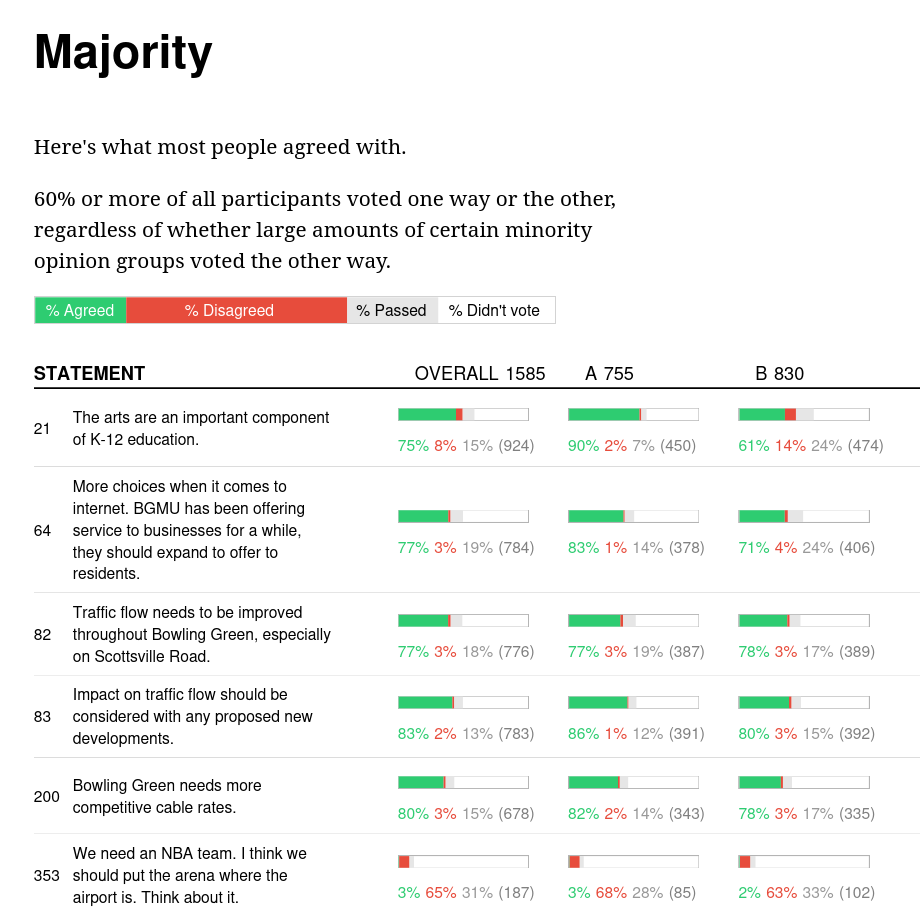
D-Agree Crowd-Scale Discussion
- Automated agent to facilitate online discussion (Ito, Hadfi, and Suzuki 2022)
- IBIS-based discussion representation
- Extracts and analyzes discussion structures from online discussions
- Posts facilitation messages to incentivize participants and grow IBIS tree
- Best results when agent augmented human facilitators (Hadfi and Ito 2022)
- Results
- Use of the agent produced more ideas for any given issue
- Agent had 1.4 times more replies and 6 times shorter response intervals
- Increased user satisfaction and sense of accomplishment
Methodology
Data
- Summary Statistics: conversation topic, number of participants, total comments, total votes
- Comments: author, comment text, moderated, agree votes, disagree votes
- Votes: voter ID, comment ID, timestamp, vote
- Participant-Vote Matrix: participant ID, group ID, n-votes, n-agree, n-disagree, comment ID…
- Stats History: votes, comments, visitors, voters, commenters
| Dataset | Participants | Comments | Accepted |
|---|---|---|---|
| american-assembly.bowling-green | 2031 | 896 | 607 |
| scoop-hivemind.biodiversity | 536 | 314 | 154 |
| scoop-hivemind.taxes | 334 | 148 | 91 |
| scoop-hivemind.affordable-housing | 381 | 165 | 119 |
| scoop-hivemind.freshwater | 117 | 80 | 51 |
| scoop-hivemind.ubi | 234 | 78 | 71 |
Embeddings
- Calculated at comment level using Sentence Transformers library
- Models considered
- intfloat/e5-mistral-7b-instruct
- WhereIsAI/UAE-Large-V1
- OpenAI/text-embedding-ada-002
- OpenAI/text-embedding-3-large
- Language Model Selection Criteria
- Open weights
- Clustering performance on HuggingFace MTEB
- Memory footprint
Text Generation
- Models Considered
- Guidance
- Python-based framework developed by Microsoft Research
- Constrain generation using regular expressions, context-free grammars
- Interleave control and generation seamlessly
lm += f"""\
The following is a character profile for an RPG game in JSON format.
```json
{{
"id": "{id}",
"description": "{description}",
"name": "{gen('name', stop='"')}",
"age": {gen('age', regex='[0-9]+', stop=',')},
"armor": "{select(options=['leather', 'chainmail', 'plate'], name='armor')}",
"weapon": "{select(options=valid_weapons, name='weapon')}",
"class": "{gen('class', stop='"')}",
"mantra": "{gen('mantra', stop='"')}",
"strength": {gen('strength', regex='[0-9]+', stop=',')},
"items": ["{gen('item', list_append=True, stop='"')}", "{gen('item', list_append=True, stop='"')}", "{gen('item', list_append=True, stop='"')}"]
}}```"""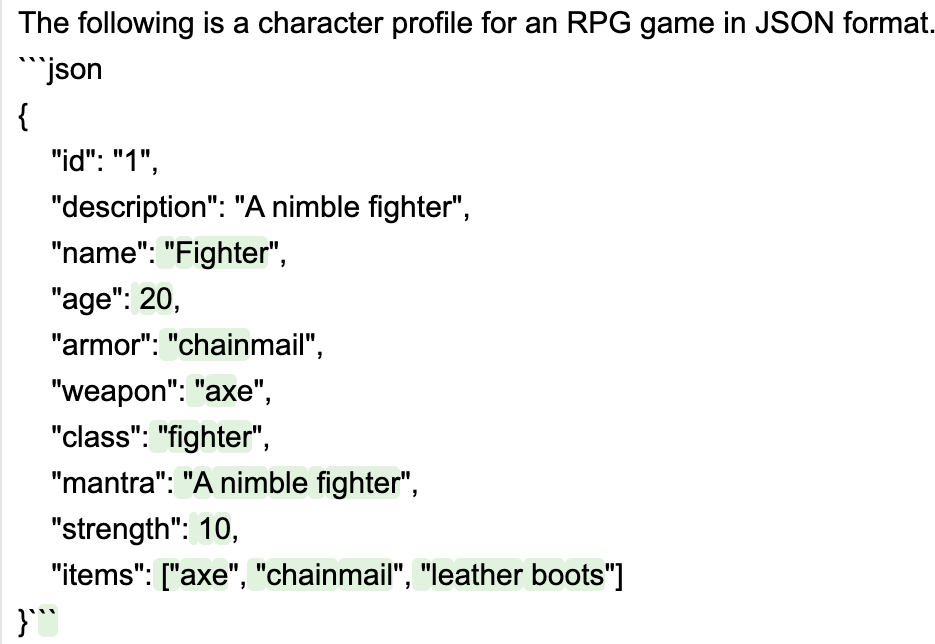
Topic Modeling
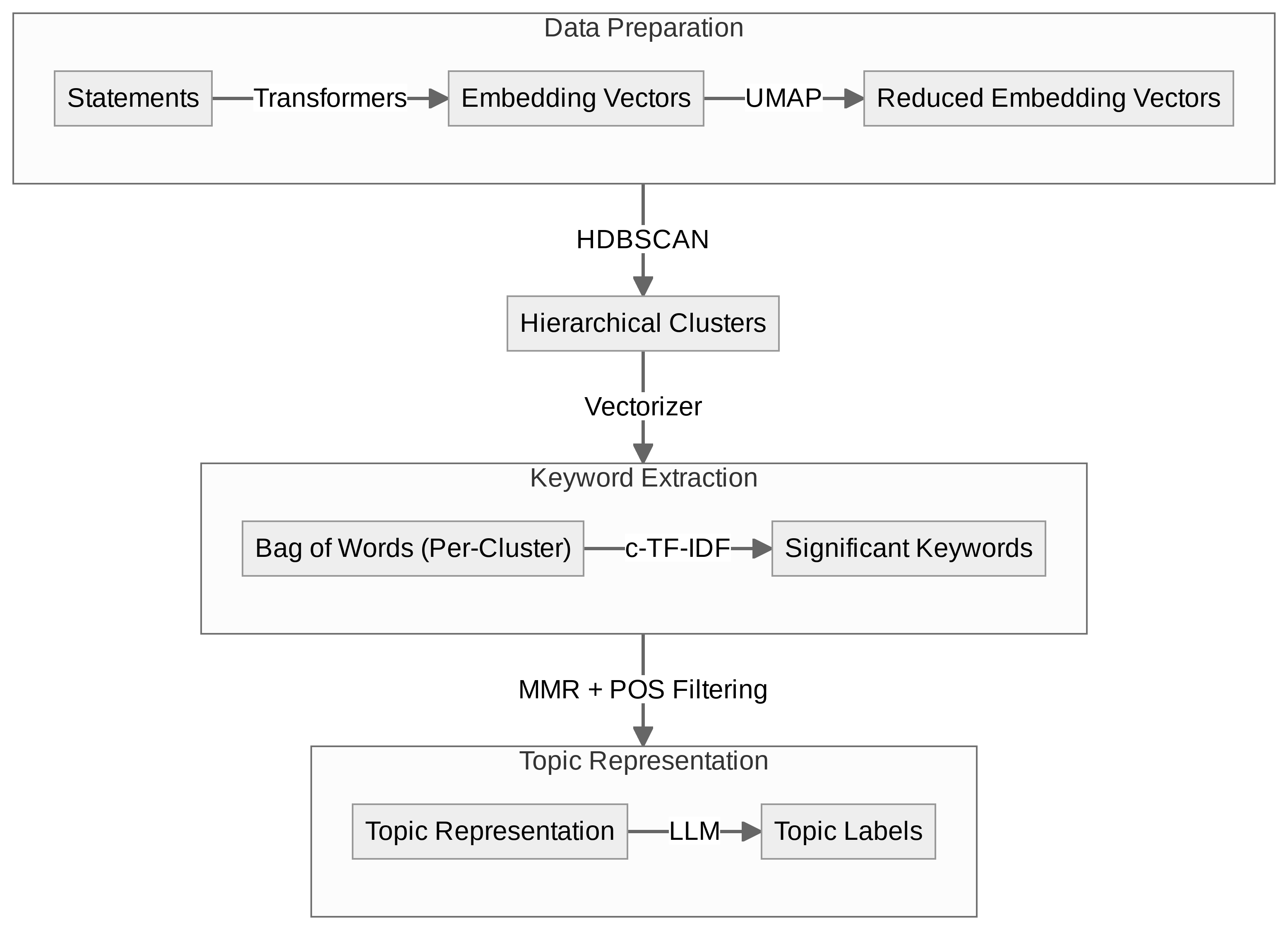
Topic Outlier Assignment
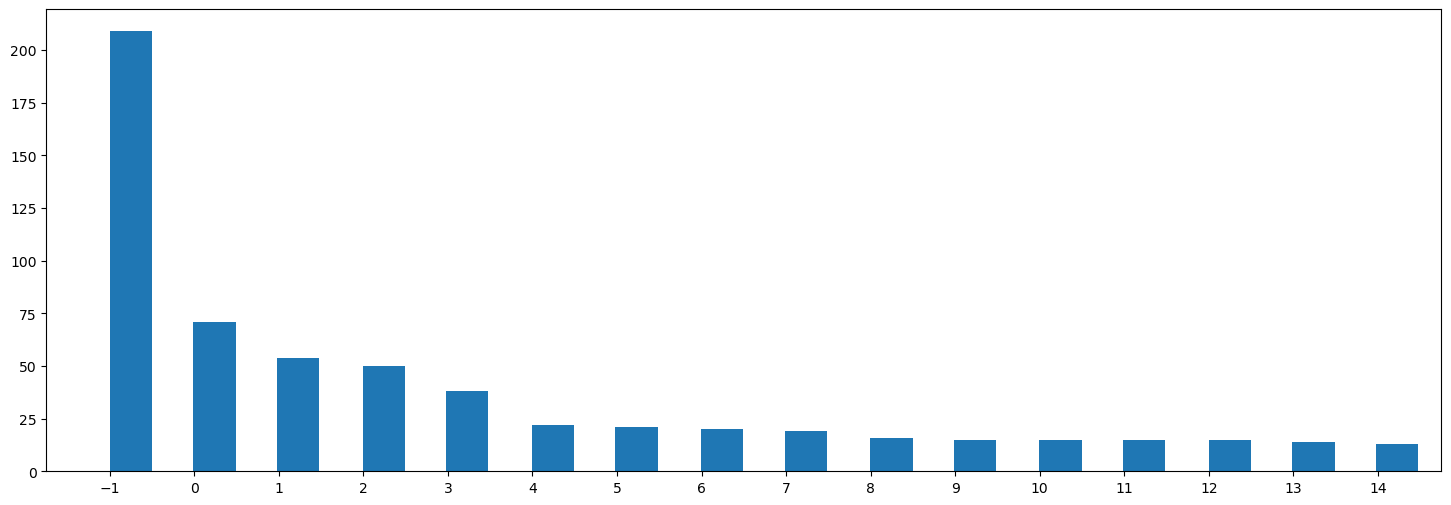
-1 is reserved for outliers that do not initially belong to a cluster.
Statement Distribution
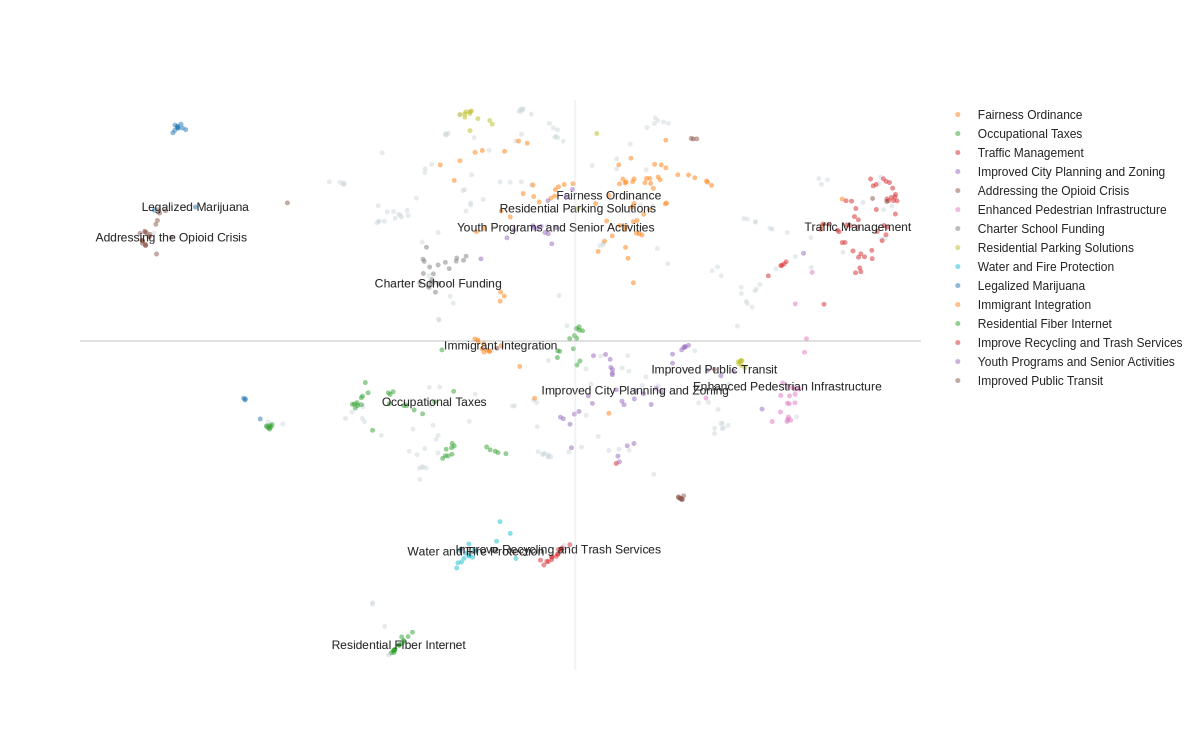
Statement Distribution after outlier reassignment
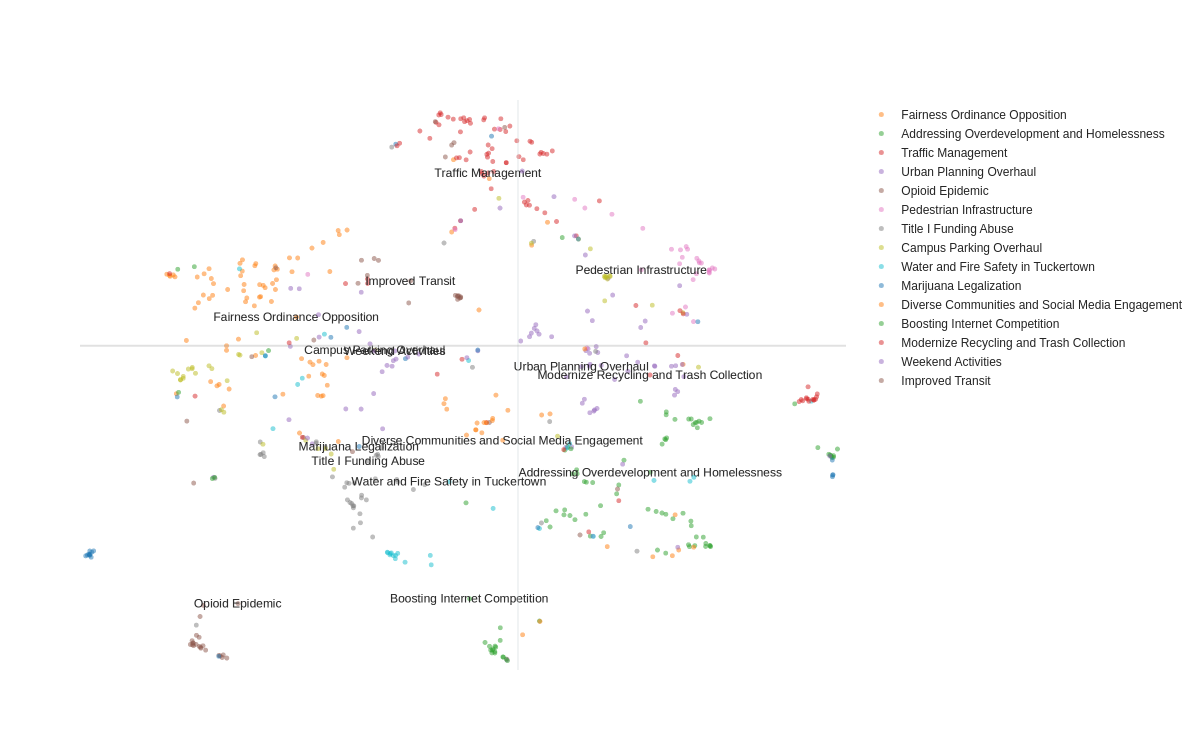
Insight Generation
- Actionable insights that urge for specific actions to address issues
- Problems and solutions proposed by participants
- LLM synthesizes insights from comments within each topic
- Advocate for specific insights urging actions to address issues
- Filter these insights to derive actionable items

Insight Scoring
- Goal: Quantify acceptance of each generated insight
- Task: Identify comments that support each insight
- Count the individuals that voted positively on supporting comments
- Calculate an “acceptance” factor to indicate the degree of consensus
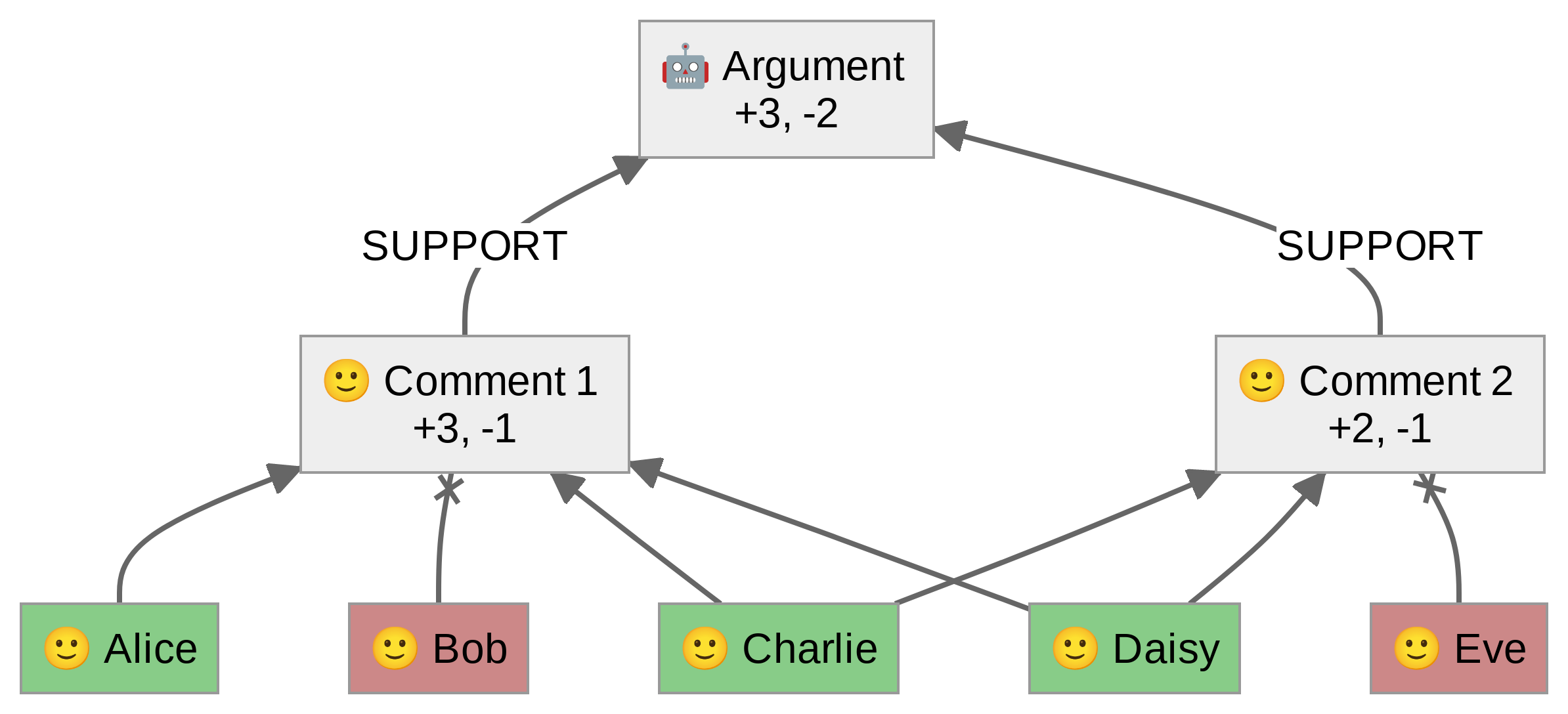
Potential Biases in Insight Generation
- Some comments, especially those posted earlier, may receive more votes than others
- Use the ratio of agreement votes to total votes
- Certain topics are more popular and have more comments than others
- Generate a balanced number of insights for each topic
- Certain controversial topics are heavily downvoted
- Comments: Filter by quantiles instead of fixed thresholds within each topic
- Insights: Select fixed number of “best insights” from each topic
- Some people vote more than others
- Count the individuals that support an insight over hard vote count
Argument Mapping
- Used Argdown syntax to generate argument maps
- Developed a grammar generator to convert data into Argdown format
- Generated argument maps for each topic to visualize the structure of the debate
===
sourceHighlighter:
removeFrontMatter: true
webComponent:
withoutMaximize: true
height: 500px
===
# Argdown Syntax Example
[Statement]: Argdown is a simple syntax for defining argumentative structures, inspired by Markdown.
+ Writing a list of **pros & cons** in Argdown is as simple as writing a twitter message.
+ But you can also **logically reconstruct** more complex relations.
+ You can export Argdown as a graph and create **argument maps** of whole debates.
- Not a tool for creating visualizations, but for **structuring arguments**.
<Argument>: Argdown is an excellent tool and should be used by the city of Bowling Green, KY.
[Statement]
+> <Argument>Argument Generation and Scoring
Opioid Epidemic and Healthcare

Argument Generation and Scoring
Community Enrichment

Conclusion
- Chaining simple tasks for complex reasoning
- Discovering topics in a large dataset and new generating valuable insights
- Risk of hallucinations and incorrect output
- LLMs’ limitations in processing complex instructions and sentences
- Complex instructions
- Relationship modeling based on double and triple negatives
- Reliability and bias
- Critical need for ethical and inclusive technology deployment
Future Research Directions
- Semantic extraction and reasoning during discourse
- Exploring connections across topics
- Generalizing techniques to platforms like Kialo, Hacker News
Questions?
Thank you!
Conklin, E. Jeffrey. 2006. Dialogue Mapping: Building Shared Understanding of Wicked Problems. Chichester, England ; Hoboken, NJ: Wiley.
Conklin, Jeff, and Michael L. Begeman. 1988. “gIBIS: A Hypertext Tool for Exploratory Policy Discussion.” ACM Transactions on Information Systems 6 (4): 303–31. https://doi.org/10.1145/58566.59297.
Grootendorst, Maarten. 2022. “BERTopic: Neural Topic Modeling with a Class-Based TF-IDF Procedure.” arXiv. http://arxiv.org/abs/2203.05794.
Hadfi, Rafik, and Takayuki Ito. 2022. “Augmented Democratic Deliberation: Can Conversational Agents Boost Deliberation in Social Media?” In Proceedings of the 21st International Conference on Autonomous Agents and Multiagent Systems, 1794–98. AAMAS ’22. Richland, SC: International Foundation for Autonomous Agents; Multiagent Systems.
Ito, Takayuki, Rafik Hadfi, and Shota Suzuki. 2022. “An Agent That Facilitates Crowd Discussion.” Group Decision and Negotiation 31 (3): 621–47. https://doi.org/10.1007/s10726-021-09765-8.
Small, Christopher. 2021. “Polis: Scaling Deliberation by Mapping High Dimensional Opinion Spaces.” RECERCA. Revista de Pensament i Anàlisi, July. https://doi.org/10.6035/recerca.5516.